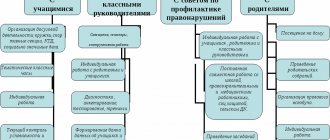The essence of conflicts. Social conflicts
Definition 1
Conflict is the most acute way of resolving contradictions in interests, goals, views that arise in the process of social interaction, consisting in the opposition of the participants in this interaction and usually accompanied by negative emotions, going beyond the framework of social rules and standards of decency.
There are a large number of definitions of social and intrapersonal conflicts, which only prove the versatility of this phenomenon and the need for its full research.
Are you an expert in this subject area? We invite you to become the author of the Directory Working Conditions
It is better to prevent conflicts than to eliminate their negative consequences. For this purpose, full-fledged action algorithms or conflict prevention technologies are being developed. It is possible to implement such technology in practice with the help of a third party or an invited expert, who is often called a mediator. It can also be an independent, objective person with great authority.
The basis for preventing a conflict of one kind or another is a change in the style of action of any participant in the conflict. As practice shows, a less effective way to prevent conflicts is to change the opponent’s views.
Definition 2
An opponent is a person who objects to someone in a public conversation, debate, etc. An opponent often expresses the opposite point of view.
Abstract on the topic “Conflicts and ways to prevent and resolve them”
Essay
on the topic “Conflicts and ways to prevent and resolve them”
Completed:
Rasulov Khairula Ramazanovich
Content
Introduction 1. The concept of conflict. Structure of conflict 2. Conflict as a manifestation of stress 3. Basic methods of resolving conflict situations 4. Psychological techniques of influence in a dispute Conclusion List of sources used
Introduction
In society, various types of conflicts between people have always arisen and manifested themselves: from family to international. Each of us has had to deal with conflict situations. People, faced with certain conflicts that arose between them, eventually found means and ways to eliminate misunderstandings.
Conflicts occupy a significant place in the life of every person, since the consequences of some of them are too noticeable over many years of life. Because of conflicts, people disagree with each other when solving various types of issues. The role of conflicts and their regulation in modern society is great; in the second half of the twentieth century, a special field of knowledge emerged - conflictology. Conflict is the most acute way of resolving contradictions in interests, goals, and views that arise in the process of social interaction, consisting in the opposition of the participants in this interaction and usually accompanied by negative emotions, going beyond the rules and norms. Most people don't care about them. When people think of conflict, they most often associate it with aggression, threats, disputes, hostility, war, etc. As a result, there is an opinion that conflict is always undesirable, that it must be avoided if possible and that it should be resolved immediately as soon as it arises. But there is an opinion that conflict is a conscious confrontation with the aim of fulfilling one’s own needs at the expense of the interests of other individuals.
Currently, psychologists are inclined to the point of view that some conflicts are inevitable, while others are not only possible, but also desirable. If the conflict is small, then it goes unnoticed and is not resolved. Which can neither affect work efficiency. A conflict that has reached a strong state is accompanied by the development of stress among its participants. A compromise solution is developed during dialogue. This decision leads to more efficient work in a particular company. The more effective conflict management is, the more constructive its consequences will be.
The purpose of this essay is to study the conflict, its structure, conflict situations, psychological methods of influence in a dispute and determine methods for resolving conflict situations.
1. The concept of conflict. Structure of the conflict
Conflict is an orderly structure of social interaction. Analysis of this structure includes identifying the main elements, such as participants in the conflict (opponents, subjects of the conflict, parties to the conflict), resources of the conflict, the causal field (object) of the conflict, the presence of any forces not directly involved in the struggle, but interested in it outcome, aspirations and interests of opponents, conditions (temporal, spatial, social, economic, etc.) in which the conflict is realized.
The structure of any object is understood as the totality of its parts, elements and connections, the relationships between them that ensure its integrity. The main elements of conflict interaction are:
1) object of the conflict; 2) subject of the conflict; 3) subjects of the conflict 4) social environment, conditions of the conflict;
1. Object of conflict. Every conflict has its own reason; it arises over the need to satisfy some need. The value that is capable of satisfying this need and because of the mastery of which conflict arises is its object. The object of conflict can be material, social and spiritual values. For example, the simplest type of interpersonal conflict is a quarrel between children in kindergarten over a toy. In this case, the object of the conflict is the toy itself as a material value.
2. Subject of the conflict. Not all textbooks and teaching aids on conflictology highlight the subject of conflict separately. However, we believe that such a distinction is necessary, as it helps to better understand the nature of a particular conflict. The nature of the conflict depends not only on the objective conditions in a given country, large or small group, but also on the subjective perception or image of the conflict that is created by individuals or groups operating in a given conflict situation. This image or perception does not necessarily correspond to the true state of affairs, the actual situation. Let’s say two young men are in conflict over a girl’s attention. The girl, in this case, is the object of the conflict, but the subject of the conflict can be both the desire of each to possess her, and the reluctance of the other to possess her. That is, the object of the conflict in different cases may be the same, but the objects differ significantly. Similar to the above example is the situation described in the book “Dowry”, based on which a film was made in which the hero kills his beloved so that she does not go to another.
As Immanuel Kant noted, our knowledge reflects not only objective nature, but also includes our own human nature as its integral part. Therefore, the relationship between our images, ideas and reality is very complex and not only never fully corresponds to it, but can also seriously diverge from it, which serves as another source of conflict.
It should be borne in mind that whatever our images, perceptions, ideas about the conflict situation, the conflict will not begin until they are realized in appropriate mutual actions. The objective and subjective causes of the conflict, arising both on its near and distant approaches, as well as the composition of the participants, determine the set of possible courses of action and behavior of the parties. Since each action of one of the parties to the conflict causes a corresponding reaction, they influence each other.
3. Subjects of the conflict (in conflict theory the terms opponents, participants in the conflict, parties to the conflict are also used) can be both individual individuals and social groups, organizations, and larger social communities (states, coalitions of states). The main participants in the conflict are the opposing parties or opponents, of which there are at least two in the conflict. They form the core of the conflict. When at least one of the main parties withdraws from the confrontation, the conflict ends.
Conventionally, opponents can be divided into three ranks. The opponent's rank is a complex characteristic of the power resources with which the fight is waged. The opponent's weakest rank is first.
Opponents of the first rank are individuals who pursue their own (personal) interests and goals in the conflict, and rely on their own strengths and means in the conflict confrontation. Most often, opponents of the first rank are individuals involved in interpersonal conflicts. For example, in a conflict between two children over a toy in kindergarten, both children are opponents of the first rank.
Opponents of the second rank are social groups (or individuals speaking on their behalf) that have transpersonal (group) interests and goals in the conflict. The volume of power resources of opponents of the second rank is significantly greater than the volume of power resources of opponents of the first rank, since they rely on. group resources in conflict confrontation.
And finally, the third rank of opponents, which is the highest. Opponents of the third rank are organizations and social institutions (or individuals speaking on their behalf). In a conflict, opponents of the third rank are guided by supragroup (social) goals and interests and values. In this regard, the volume of power resources of third-rank opponents is practically unlimited.
It should be noted that the ranks of opponents are not strictly fixed throughout the conflict. For example, if in a conflict between a student and a teacher the student is supported by the group, then his rank changes from first to second. A reduction in rank is also possible, using, among other things, immoral methods (in wrestling, all means are good). Let us illustrate the situation with the following example. Let’s say that we have an organization in which one of the employees systematically does not fulfill her duties, that is, she skips work, is late, goes home early, and justifies her behavior by having children. In the end, the manager makes the decision to fire. However, this employee begins to claim that this is supposedly revenge for the fact that her manager once pestered her, and she refused him. Thus, the rank of the leader changes from third to first. In conflict theory, such a situation is called substitution of the conflict object (false object).
From the above it follows that the significance and influence of the parties to the conflict do not always correspond to the specified sequence. As history shows, the role of individuals not only in the life of individual organizations and groups, but also in the destinies of entire nations and states can be very great. The role of individual participants in the conflict is also different from a psychological point of view; in this regard, it can be sublime, even heroic, or it can also be base and unsightly. Each participant can be guided during the development of the confrontation by his own motives, goals, interests, values and attitudes. Both the social significance of the participants and their goals and attitudes appear especially clearly only when the conflict reaches a high degree of development. It is at this time that the “moment of truth” comes in the development of the conflict, it becomes clear who is who among its participants.
In addition to the main parties to the conflict, there may be other participants who play secondary roles in it. These roles can be both significant and insignificant, up to the roles of the so-called “people from the crowd.” The roles of the parties to the conflict are not the same. They differ from both sociological and psychological points of view. From a sociological point of view, they can differ significantly in their social significance, strength, and influence, which is especially clearly revealed when an individual collides with the state. Of course, in a conflict of this kind, the forces of the participants are far from equal, as evidenced by the tragic fates of the “dissidents” who actively opposed the Soviet state.
4. But, in addition to the participants in the conflict, the totality of which constitutes its microenvironment, the macroenvironment, those specific historical socio-psychological conditions in which it unfolds, also plays an important and sometimes decisive role in its development. The concept of social environment defines the ground on which conflict arises and develops. This concept includes not only the immediate, but also the distant, broader environment of the conflicting parties, the large social groups to which they belong, national or class, as well as society as a whole.
2. Conflict as a manifestation of stress
Conflict as a manifestation of stress is a very common cause of conflict. In this case, one or more participants in the pre-conflict situation may be in a state of stress. In addition, stress can accumulate among all group members as a result, for example, of difficult living and working conditions.
The term “stress” (goes back to the English “stress”) is tension and means a set of protective physiological reactions that occur in the human body in response to the influence of various unfavorable factors (stressors). Stress is based on overload of the nervous system.
Communication conflicts and interpersonal clashes often cause psychological trauma. Stress is a short-term disorder of the nervous system that goes away on its own when the irritating factor disappears. They are observed in the life of almost every person.
In an organizational system, conflicts that cause stress can be prevented by the following organizational and managerial actions:
- “Make the roles clear!” – strictly monitor compliance with instructions by employees.
- “Formulate a common goal for everyone!” – determination of clear goals for individual units and group members over a certain period.
- “Give vent to your feelings!” – attentive listening to the complainant, emotional support, but not necessarily agreement; please explain everything in detail.
- “Listen one by one” - any attempts at slander are suppressed; calling both “to a confrontation”, announcing one’s decision: in favor of one or not in favor of both.
- The “method of emotional compensation” is to find the good in the conflict and point out it.
- “Authoritative third” is the transfer of a good opinion of one about the other through a third person who is authoritative for both.
- “Detection of aggression” - providing an opportunity to express hostility towards each other in a disguised form: a game, a dispute, a competition.
- “Forced listening to the opponent” is forced to listen to each other’s arguments in good faith.
- “Exchange of positions” - offer to express claims on behalf of the opposing party.
- “Mirror” – record a quarrel on a tape recorder.
- “Remind about the bonus” - remind about the strict system of sanctions: rewards and punishments.
- “Discuss at the meeting” – rely on the support of group opinion.
- “Make a strong-willed decision for the conflicting person!”
- “Adopt primary methods of punishment.”
- “Transfer” – warn and separate conflicting parties into different departments.
3. Basic methods of resolving conflict situations
Conflict management is a targeted impact on eliminating (minimizing) the causes that gave rise to a conflict, or on correcting the behavior of participants in the conflict.
There are quite a lot of conflict management methods. Enlarged, they can be represented in the form of several groups, each of which has its own area of application:
1) intrapersonal, i.e. methods of influencing an individual;
2) structural, i.e. methods for eliminating organizational conflicts;
3) interpersonal methods or styles of behavior in conflict;
4) negotiations;
5) retaliatory aggressive actions. This group of methods is used in extreme cases, when the capabilities of all previous groups have been exhausted.
1 Intrapersonal methods consist in the ability to correctly organize one’s own behavior, express one’s point of view without causing a defensive reaction on the part of the other person.
2 Structural methods, i.e. methods of influencing primarily organizational conflicts arising due to improper distribution of powers, labor organization, adopted incentive system, etc. Such methods include: clarifying job requirements, coordination and integration mechanisms, organization-wide goals, and the use of reward systems.
Clarifying job requirements is one of the effective methods for managing and preventing conflicts. Each specialist must clearly understand what results are required of him, what his duties, responsibilities, limits of authority, and stages of work are.
Coordination and integration mechanisms. This is another method of managing a conflict situation. One of the most common mechanisms is the chain of command. Establishing a hierarchy of authority streamlines the interaction of people, decision making and information flows within the organization. If two or more subordinates disagree on an issue, the conflict can be avoided by approaching a common superior, inviting him to make a decision. The principle of unity of command facilitates the use of hierarchy to manage a conflict situation, since the subordinate knows whose decisions he must implement.
Equally useful are integration tools such as cross-functional teams, task forces, and interdepartmental meetings. For example, when in one of the companies there was a conflict between interdependent departments - the sales department and the production department - an intermediate service was organized to coordinate the volume of orders and sales.
Organization-wide comprehensive goals. Effective implementation of these goals requires the joint efforts of two or more employees, departments, or groups. The idea behind this technique is to direct the efforts of all participants to achieve a common goal.
Reward system structure. Rewards can be used as a method of conflict management, influencing people to avoid dysfunctional consequences. People who contribute to the achievement of organization-wide integrated goals, help other organizations and try to approach problems in a comprehensive manner should be rewarded with gratitude, bonuses, recognition or promotions. It is equally important that the reward system does not reward unconstructive behavior by individuals or groups.
The systematic, coordinated use of reward systems to reward those who contribute to the achievement of organization-wide goals helps people understand how they should act in a conflict situation in a manner consistent with management's desires.
3. Interpersonal conflict resolution styles
Evasion. This style implies that a person is trying to avoid conflict. His position is not to get into situations that provoke the emergence of contradictions, not to enter into a discussion of issues that are fraught with disagreement. Then you won’t have to get into an excited state, even if you are trying to solve a problem.
Smoothing. With this style, a person is convinced that there is no need to get angry because “we are all one happy team, and we should not rock the boat.” Such a “smoother” tries not to let out the signs of conflict, appealing to the need for solidarity. But at the same time, you can forget about the problem underlying the conflict. The result may be peace and quiet, but the problem will remain, and eventually there will be an “explosion.”
Compulsion. Within this style, attempts to force people to accept their point of view at any cost prevail. The one who tries to do this is not interested in the opinions of others, usually behaves aggressively, and uses power through coercion to influence others. This style can be effective where the manager has great power over subordinates, but cannot suppress the initiative of subordinates, creates a high probability that the wrong decision will be made, since only one point of view is presented. It can cause resentment, especially among younger and more educated staff.
Compromise. This style is characterized by accepting the other party's point of view, but only to some extent. The ability to compromise is highly valued in management situations as it minimizes ill will, often allowing conflict to be resolved quickly to the satisfaction of both parties. However, using compromise early in a conflict over an important issue can reduce the time it takes to find alternatives.
Solution to the problem. This style is an acknowledgment of differences of opinion and a willingness to engage with other points of view in order to understand the causes of the conflict and find a course of action acceptable to all parties. Someone who uses this style does not try to achieve their goal at the expense of others, but rather looks for the best solution. This style is the most effective in solving organizational problems.
4.Negotiations
Negotiations represent a broad aspect of communication, covering many areas of an individual’s activity. As a method of conflict resolution, negotiations are a set of tactics aimed at finding mutually acceptable solutions for conflicting parties.
In order for negotiations to become possible, certain conditions must be met:
– the existence of interdependence of the parties involved in the conflict;
– absence of significant differences in the capabilities (strength) of the subjects of the conflict;
– correspondence of the stage of development of the conflict to the possibilities of negotiations;
– participation in negotiations between parties who can actually make decisions in the current situation.
It is believed that it is advisable to negotiate only with those forces that have power in the current situation and can influence the outcome of the event. There are several groups whose interests are affected in the conflict:
– primary groups – their personal interests are affected, they themselves participate in the conflict, but the possibility of successful negotiations does not always depend on these groups.
– secondary groups – their interests are affected, but these forces do not strive to openly demonstrate their interest, their actions are hidden until a certain time. There may also be third forces that are also interested in the conflict, but even more hidden.
Properly organized negotiations go through several stages:
– preparation for the start of negotiations (before the opening of negotiations);
– preliminary choice of position (initial statements of participants about their position in these negotiations);
– search for a mutually acceptable solution (psychological struggle, establishing the real position of opponents);
– completion (exit from a crisis or negotiation impasse).
– To reduce the intensity and resolve conflicts, methods related to:
– with increased administrative pressure (power pressure) on those in conflict from the top management;
– with a change in the order of expenditure or redistribution of resources;
– with changes in production technologies or decomposition (separation) of technologies and their distribution between structural divisions;
– with a change in the structure of the organization with subsequent redistribution of functions (including the merger or division of divisions into parts);
– with the introduction of a special integration unit: general manager, curator, etc.
A manager can significantly increase the chances of joint conflict resolution if, when discussing conflicts, he makes it clear through his behavior that he considers constructive conflicts a normal phenomenon and, by participating in their resolution, acts not as a dominant force, but on an equal basis with everyone.
The list of rules given below provides guidelines for a line of behavior that counteracts the emergence of conflicts.
Basic Rules:
- Recognize each other.
- Listen without interrupting.
– Demonstrate understanding of the other’s role.
– Find out how the other perceives the conflict, how he feels about it.
– Clearly formulate the subject of discussion.
– Establish common points of view.
– Find out what separates you.
– After this, describe the content of the conflict again.
– Look for a general solution.
– Adopt a general communiqué.
General recommendations for resolving a conflict situation can be summarized as follows.
1. Recognize the existence of a conflict, i.e. recognize the existence of opposing goals and methods among opponents, and identify these participants themselves. In practice, these issues are not so easy to resolve; it can be quite difficult to admit and state out loud that you are in a state of conflict with an employee on some issue. Sometimes the conflict has existed for a long time, people suffer, but there is no open recognition of it, everyone chooses their own form of behavior and influence on the other, but there is no joint discussion and way out of the current situation.
2. Determine the possibility of negotiations. After recognizing the existence of a conflict and the impossibility of resolving it “on the spot,” it is advisable to agree on the possibility of holding negotiations and clarify what kind of negotiations: with or without a mediator and who can be a mediator that is equally satisfactory for both parties.
3. Agree on the negotiation procedure. Determine where, when and how negotiations will begin, i.e. stipulate the timing, place, procedure for conducting negotiations, and the start time of joint activities.
4. Identify the range of issues that constitute the subject of the conflict. The main problem is to define in shared terms what is in conflict and what is not. Already at this stage, joint approaches to the problem are developed, the positions of the parties are identified, the points of greatest disagreement and points of possible convergence of positions are determined.
5. Develop solutions. The parties, when working together, offer several solution options with cost calculations for each of them, taking into account the possible consequences.
6. Make an agreed decision. After considering a number of possible options, during mutual discussion and provided that the parties come to an agreement, it is advisable to present this general decision in writing: communiqué, resolution, cooperation agreement, etc. In particularly complex or responsible cases, written documents are drawn up after each stage negotiations
7. Implement the adopted decision in practice, if the process of joint action ends only with the adoption of a well-developed and agreed upon decision, and then nothing happens or changes, then this situation can be the detonator of other, stronger and longer-lasting conflicts. The reasons that caused the first conflict have not disappeared, but have only been strengthened by unfulfilled promises. Repeated negotiations will be much more difficult.
4. Psychological methods of influence in a dispute
Any exchange of views may contain elements of dispute, because the same phenomenon causes different “reactions in people due to their personal characteristics, depending on the situation. Forms of interaction such as persuasion, influence and negotiation almost never take place without controversy. Therefore, in any field, use the techniques that were described in the relevant sections of this manual. The most commonly used are: manipulation, paraphrasing, various tricks and “homemade preparations”. A dispute consists of a set of various kinds of critical remarks, attacks, and techniques associated with their effective reflection or neutralization.
They highlight objective comments related to the need to dispel doubts, clarify the essence of the matter, express disagreement with something or someone. These kinds of comments are usually not argued with - they are given reasoned answers, or they are ignored. Subjective comments. Many people consider themselves and their problems to be unique and require increased attention from others. You need to respond to such comments formally and politely. Comments related to the desire to prove oneself, to show one’s importance compared to others: you need to let them speak out. Aggressive remarks are caused by a desire to simply take revenge. For example, if someone says that women are generally poorly versed in technology, then the wounded female designer present may boil over and start a heated argument.
Ironic remarks are akin to this. They are used, as a rule, by those who want to hurt or prick a partner, either in revenge or because of a bad mood. Often teasing is intended to debunk and belittle the speaker in the eyes of the public. It is better not to respond to ironic remarks. The desire to delay making a decision also causes comments. They are intended to show that the interlocutor’s arguments are supposedly not entirely indisputable, that the proposal is still “raw,” etc. You shouldn't parry every remark; to give immediate answers is better to think a little for the sake of appearance; “to leave”, to laugh it off; change the topic of conversation. It is recommended: 1. Refer to the partner’s arguments, authority or experience and opinions of people whom he values. 2. “Approval + destruction”: the remark is accepted unconditionally, but then its significance is diminished. 3. The method of elastic defense or delay: when the interlocutor is irritated, you need to gain time, for example, by taking the conversation a little to the side until the partner cools down. 4. Instead of direct answers, you can draw an analogy with a situation that the interlocutor knows well. 5. Paraphrasing a statement can reduce its impact. 6. Direct question technique: Do you want to make a strong impression on the girls present?
Conclusion
Conflict means disagreement between the parties. Most people believe that conflict is a negative phenomenon and try to avoid it whenever possible. The ability to manage conflict can be decisive for the survival of the team as a whole. To effectively manage the development of a conflict, it is necessary to diagnose it with maximum accuracy. Then find out who is involved in the conflict, determine the needs and concerns of each participant in the conflict situation related to this problem.
The ideal is to perceive the conflict as it really is. Underestimation of the conflict can lead to the fact that its analysis will be carried out superficially and the proposals made on the basis of such analysis will turn out to be of little use. Underestimation of the conflict may have objective and subjective reasons. Objective ones depend on the state of information and communication systems, and subjective ones depend on the inability or unwillingness of an individual to appropriately assess the situation that has arisen. Not only underestimation, but also overestimation of the existing confrontation is harmful. In this case, efforts are made much greater than is really necessary. Overestimating a specific conflict or over-insurance regarding the possibility of a conflict incident can lead to the discovery of a conflict where there really is none. If you manage conflict skillfully, it strengthens both the team and the organization as a whole, and helps to develop a common management concept in both small and large organizations.
You can prevent conflicts by changing your attitude to a problem situation and behavior in it, as well as influencing the psyche and behavior of your opponent. To prevent interpersonal conflicts, it is necessary to evaluate, first of all, what was accomplished, and then what was not accomplished: the evaluator must know the activity well; give an assessment on the merits of the case, and not on the form; the evaluator must be responsible for the objectivity of the assessment; identify and communicate to assessed employees the reasons for deficiencies; clearly formulate new goals and objectives; inspire employees to take on new jobs. Compliance with these recommendations will help the conflicting parties prevent conflict situations, and if they occur, resolve them constructively and find the optimal way out of the conflict.
List of sources used
1. Ratnikov V.P. Conflictology: textbook/V.P. Ratnikov. – M.: UNITY – DANA, 2005. 2. Antsupov A.Ya., Shipilov A.I. Conflictology. Textbook. 3rd ed. St. Petersburg: Peter, 2007. 3. Grishina N.V. Psychology of conflict. St. Petersburg: Peter, 2008. Internet resources 1. www..wikipedia 2. https://kashin-daniil.blogspot.ru 3. https://studopedia.ru 4. https://academy35.ru 5. https www.rae.ru
Conflict Prevention
Preventing conflict becomes much easier if a person independently strives to change his own behavior. To effectively prevent conflicts, you can use the following techniques:
Finished works on a similar topic
Coursework Conflict Prevention 450 ₽ Essay Conflict Prevention 240 ₽ Examination Conflict Prevention 200 ₽
Receive completed work or specialist advice on your educational project Find out the cost
- At the latent stage of the conflict, special attention must be paid, since it is not momentary and takes a significant period of time. During this time, you can record the beginning of pre-conflict interactions and change your own behavior. For example, it is advisable to partially admit that the interlocutor is right and change the topic of conversation, remain silent or return to the topic of conversation a little later;
- At the stage of conflict unfolding, it is advisable to clarify as accurately as possible the motives and interests of the opponent and express one’s own opinion, so that the causes of conflict situations are not added to the direct misunderstanding of people by each other.
At the same time, you should always remember that preventing conflict is easier at the initial stage and difficult at the stage of open conflict confrontation.
Showing patience can earn your opponent's respect for you and set him up to reduce the degree of conflict.
In order to prevent conflict, it is also possible to predict the possible course of development of the contradiction, this will help to minimize negative emotions and act rationally.
If a person loses control of the situation, then the conversation can be reduced to a joke, since its continuation most often turns out to be unproductive. Such an action will not be a way of hushing up the problem, since the conversation can be resumed at another time.
If a person tries to change the behavior and views of his opponent in order to prevent a conflict situation, then he needs to remember the following rules:
- a person’s opinions and actions do not change instantly;
- each person is a unique personality, whose behavior is determined by the level of his individuality;
- it is impossible to expand the area of contradictions with the opposing side;
- if the opponent’s position is criticized, then there is no need to mix analysis and one’s own attitude with the actual qualities of the opponent.
To extinguish the conflict, you should become an example for your opponent of changing behavior and give in several positions in order to get a result.
Basics of preventive activities in conflict prevention
Prevention must take into account the limits of intervention, but it is necessary, and it must begin with identifying the source of the conflict. And for this you need:
- Know the potential causes of tension. They can be both external and internal problems.
- The second step is to identify hidden obstacles.
- The next step is to correct the problem by reacting appropriately. Possible solutions are: establish communication, find a compromise; take a defensive position; change strategy and tactics.
Summarizing experience and practice in the field of conflict prevention, we can highlight the following approaches:
- Cooperation is the establishment of a climate of mutual trust, mutual assistance and mutual support between employees.
- Organizational methods for preventing conflicts: comprehensive training of employees, regular rotation of personnel.
- Competition is a way of interaction between people.
Practice shows that the main emphasis is placed on the line of cooperation, which is the goal of all means and methods of management at the psychological and organizational levels, although sometimes competition can be used.
Conflict resolution can prevent more serious conflicts from occurring that might have occurred if it had not been done. After conflicts are over, the quality of individual activity of managers and employees increases.
How to resolve the conflict?
First of all, you need to understand its type (we’ll talk about this below), the reasons (what all the fuss is about) and start correcting the situation.
There are three ways to resolve the conflict:
- negative - the parties to the conflict are not inferior to each other, the conflict is getting worse. Further aggravation of relations is possible up to their rupture;
- compromise - both sides make concessions and find a solution that satisfies them. The conflict ends;
- constructive - the parties find a solution that leads to strengthening of relations.
It is clear that the third way is the most correct. In this case, conflict situations may no longer recur. In the first case, this is practically impossible - the parties to the conflict will fight to the death. And even the second method is not a panacea - a compromise may work one or several times, but in the future it ceases to satisfy both parties.
However, if the parties have a desire to resolve the conflict (and almost everyone has it, because few people like being in a state of war. The exception is toxic employees who truly enjoy quarrels and intrigues), then the chances of success are high. It is you, as a leader and experienced manager, who must take on the role of peacemaker. How to do this?
Signs of conflict.
Emergency stop.
At the beginning of their career, everyone has probably encountered a situation when the assigned task simply did not move. It seems that the task is understandable and the knowledge is there, but there is a stupor. Newcomers are afraid that they will be accused of incompetence, so they make a big mistake: they remain silent. As a result, the work is not done, day “X” comes and panic begins. The rest of the workers rush out of their places and clear away the rubble. The result is dissatisfaction and hostility of the team.
What to do? Drivers on the road stop and turn on the emergency lights. The first thing you can do in the office is to go up to another employee or manager and directly say “I’m confused” and ask for help. Sometimes a ten-minute explanation is enough to see the solution to a problem.
Overtaking rules.
Do you want to make better decisions, find your ideal career, realize your maximum potential and receive instructions for individual development?
?
All this can be done using the Human Design
. Build your map and get basic decryptions for free.
During the interview, personnel officers check candidates for initiative. But with joining an established team, the situation changes. If you were not hired for the position of a super-creative mass entertainer, you should not run to your manager on your first day with a proposal to improve your work. Or even worse, contact the “boss of the boss” directly.
What to do? Remember the rules for overtaking. First, understand the situation, talk with colleagues, turn on an imaginary “turn signal.” That is, make it clear to others what you are going to do. Sometimes ideas that seem fresh and useful to a newcomer have already been discussed more than once at general meetings. Then you can contact your direct manager. Overtaking done according to all the rules will not cause irritation to anyone.
Timely signal.
Nothing irritates a driver more than the sound of a horn from behind. Nothing irritates colleagues more than a deafening phone ringtone (well, so that I can hear from afar), loud conversations on the phone (I’m at work), discussion of personal problems, loud laughter, thoughts out loud. In general, everything that prevents others from concentrating on work.
What to do? Remember, the signal button is provided for emergency situations. If you mute the ringtone, turn off the speakers on your computer, your colleagues will only be grateful to you. To discuss work issues, there are meeting rooms in the offices. If there is no way out and you need to talk in a common office, then you can “honk the horn” and apologize.
Take a personality type test
Sloppy on the road.
Motorists know that they can be fined for a dirty car, so they don’t skimp on washing them. For some reason, many people neglect this rule at work. Does a desk littered with papers seem to create the appearance of work? But no. It’s especially annoying for colleagues and bosses when they urgently need to find the required document on a slob’s desk. The instructions “open 25 folders and maybe in one of them you will find...” not only infuriate, but also slow down your work.
What to do? Arrange a wash on your desktop (real and virtual). This will make life easier not only for your colleagues, but also for you personally. If you have to urgently go on a business trip or go on sick leave, the deputy will easily find the necessary folder. And your colleagues won’t bother you with additional calls.
Hit.
Maintaining personal space in a small office is difficult. Therefore, unceremoniousness on the part of colleagues is perceived sharply. People who take personal cups without permission, empty supplies of cookies or coffee, sit on the table or rummage through a work computer are quietly hated. They are also being boycotted.
What to do? If you cut someone off or run over someone, be prepared for retaliatory aggression. And it doesn’t matter that at your previous place of work you had everything in common and no one complained. Every office has its own unspoken rules. If you desperately need someone else's item, it is better to ask permission and be sure to return it to its place.
Driving culture.
Drivers know that reckless drivers cut off and change lanes sharply on the road not because they are so smart. But because others allow them to do so. Therefore, the results of a successfully completed business or project should not be attributed to one person. Of course, the manager has to take on more responsibility, but still the result is the merit of the entire team.
What to do? Don't forget about gratitude. If a car is missed on the road, the driver is “thanked” by flashing the headlights. In the office, you should sincerely thank the person, this will be enough. If you were helped out collectively, you can order pizza for the office or come up with something more interesting. And then, next time they will help you with even more enthusiasm.







